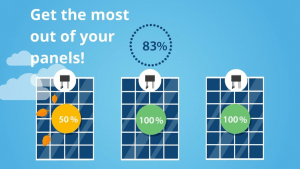As more and more optimisation products enter the market (some of you may have heard of SolarEdge inverters with their own brand of optimiser or Tigo optimisers) I thought it would be a good time to explain when it is advisable to look down the path of including optimisation in your solar system.
What problem are optimisers solving?
A standard solar system is made up of solar panels wired together in a ‘string’, and work in unison to produce energy. For example if you install ten 300 watt panels in a single string, and each panel is in full sun it may be producing at 300 watts (by ten panels = 3,000 watts).

Solar panels in solar system 100% performance
When one panel in that string becomes affected by shade (from a cloud, tree branch, or even a bird!) it may only be able to produce at 150 watts. This is where the problems start because that shaded panel will drag the production capability of the entire ten panels in the string down with it. The result – all ten panels will be producing 150 watts thereby reducing the entire solar systems’ generation capabilities by half (a total of 1,500 watts).

Solar panels in solar system 50% performance cloud shading
What is an Optimiser?
This is an ideal situation to consider installing optimisers with your panels in order to maximise the output. An optimiser is basically a small black box that slips behind and attaches to each panel and provides a technology that allows each panel to work independently of each other.

LG Neon2 solar panel with tigo optimiser brisbane house

LG solar panel brisbane tigo optimiser solution solar
For a more in-depth explanation for the tech savvy out there, see this link: https://www.tigoenergy.com/ts4/or
https://www.youtube.com/watch?v=-oe-Ma6bk-o
Optimised production
Once panels in a string are optimised by the above unit and can operate independently of one another they aren’t limited to producing at the same rate as the worst producing panel. The outcome – a system that produces far more energy overall than a system that is not optimised. From the above example we may have one panel producing at 150 watts and the remaining nine panels still producing at 300 watts. The result – (9 x 300 watts) + (1 x 150 watts) = 2,850 watts. Obviously far more attractive figures than the 1,500 watts the standard, unoptimised panel setup was producing.

improved solar panel system performance optimised
Conclusion
Installing optimisers with your solar system is a commercial decision, so not every solar system requires (or is economical) to be optimised. If you have concerns about potential shading issues from surrounding buildings or trees, or are situated on a busy street or industrial area and may be prone to accelerated or uneven soiling on your roof it may be a good time to consider what optimisers can do for you.
If you have further queries or would like some more information please don’t hesitate to contact Spinifex Energy.
info@spinifexenergy.com.au






0 Comments